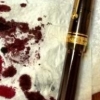Search the Community
Showing results for tags 'galileo'.
-
The Knox Galileo is a slim, steel-nibbed, metal-barreled fountain pen. It is sold by xFountainPens.com (with which I have no affiliation) for $14.99. I do not know of it being sold by anyone else. It is available in four colors: cherry red, midnight black, navy blue, and Galileo orange; and in four nib sizes: EF, F, M, and B. It has been available for some time, but, so far as I can find, the only discussion of it on this Web site has been in a thread that I started about a year ago inquiring whether anyone had experience with any of the three models of Knox pen sold by xFountainpens, which elicited a couple of reports. 1. Appearance and design I bought the pen in so-called cherry red, which is absolutely nothing like the color of any cherry that I have ever seen. As you can see from the photograph immediately below, it is more like the color of a Ferrari. The specks that you can see on the barrel are dust particles, not blemishes in the finish. The finish is perfectly even and well-polished. All the parts of the pen that are visible when it is capped are of metal: the barrel and cap, which are painted; the end-pieces of the barrel and cap, the clip, and the band at the base of the cap, which are of chrome finish; and the little black bit below that on the cap, which I believe is just painted on. The band has "KNOX" engraved in it. The clip, you will notice, is quite robust and is of a somewhat unusual shape. You can see that more clearly in the next photo. The nib is done in two tones—rather unfortunately, it seems to me, as a plain chrome finish would have agreed better with the chrome trim of the rest of the pen. It is on the small side, in keeping with the rather slim profile of the pen. (More on the nib below.) 2. Construction and quality The pen comes with a convertor. One nice feature of the design is that, as you can see in the next photograph, the base of the grip section is of metal, so that when you screw the grip section back into the barrel, you are screwing metal into metal, so that there is no danger of cracking the threads, as can happen with all-plastic grip sections. And now I come to the one flaw of construction in the pen—at least in the specimen that I got. The first thing that I did with the pen when I got it was to remove the cap and try to post it on the barrel. It would not go on. I could set the cap on to the end of the barrel, but it would simply perch there loosely and would rattle around or fall off if the pen was used. I found this rather exasperating, as I strongly prefer to use my pens with the cap posted. I tried applying a bit of pressure and heard a snap, whereupon the cap fit into the proper posting position. However, when I replaced the cap on the writing end of the pen, I found that its fit was looser than before. I believe that the plastic inner cap cracked when I posted it. I have had no problems of the nib drying out since then, and the cap will stay in place, but it comes off more easily than I think it should. It would not be safe, for example, to wear this pen clipped into a pocket, for fear of the barrel coming out of the cap. Neither of the two persons reporting on their own Galileo pens in the thread that I cited earlier (posts #21 and #23) reports having any such problem as this. 3. Weight and dimensions The pen is rather slim, which in general is not agreeable to me; however, I find that my thumb and index finger tend to stay in place at the widest point of the grip section, just below (if the pen is held in writing position) where the barrel begins, so that I can hold it comfortably. The balance is comfortable for me. Length, capped: 13.9 cm; uncapped (body only), 12.4 cm; posted, 15.3 cm. Width at narrowest point of grip: approx. 0.85 cm; at thickest point in barrel, approx.1.1 cm. Weight: 23.6 g; body, 16.4 g; cap, 7.2 g. 4. Nib and performance I ordered the pen with a broad nib. With it I ordered a second nib in medium. (The nib is the Knox K26, not the larger K35 that fits into the "Bülow" or Jinhao X450.) This turned out to be very fortunate, as the broad nib proved unusuable for me. The photograph below shows a sample of some writing done with the broad nib, in J. Herbin Bleu nuit ink, with the addition of a note in the margin made after I had replaced the B nib with the M nib. Some might find the writing with the B nib to their taste, but to me it seems a soppy mess. To be sure, the writing was made on the back of a page of a composition book that already had writing on the other side, not on Clairefontaine or the like. And, I should confess, getting a B nib was a bit of an experiment for me, as I don't generally use them. Still, this nib laid down more ink than I like. I much prefer the M nib, and now use it exclusively in the pen. Knox is already well-known, I believe, as a manufacturer of nibs. These nibs are well up to their standard, writing very smoothly and evenly, with no problems of skipping. They seem to be on the wet side, but I have not tried them with a great variety of inks (I think Bleu nuit is on the wet side itself). Also, the pen is an easy starter. So far, it has always begun to lay down ink immediately for me—though I have not yet left it unused for more than a day or two at a time. 5. Filling system and maintenance I have mentioned the convertor, which, as far as I can tell, is just the standard sort. The pen also takes cartridges. It is easy to remove and replace the nib and feed for cleaning. 6. Cost and value It's fifteen US dollars, people! That's for a metal-barreled fountain pen with a convertor. And you can get all the additional nibs you want for $9 each or the EF, F, and M nibs together for $18. 7. Conclusion The one flaw that I reported in this pen may be peculiar to my specimen, and my experience with the vendor has been that they would immediately send me a replacement if I were to ask for one, so if you could possibly have a use for a fountain pen of this description, I think it is worth it to get one of these. There are, however, two other models made by Knox that are also available on the xFountainPens site, whose designs some users may prefer.
- 17 replies
-
Are we ever going to see the FPN inks? I have a feeling after following for more than a year, and the topic being locked that we are never going to see these again.
-
My first ink mixing efforts of note are above. After a very exciting couple of weeks after orderingI recently received the FPN Galileo Manuscript Brown (there was a little surprise sample with it - thanks Amber! - but I'll leave a review of that for another day). After reading the reviews of the FPN Galileo Manuscript Brown I was expecting it to be on the red side, but I was a little disappointed to see that for me it was more red than brown. I found it almost similar in look to Diamine Oxblood or even Ancient Copper, but not as dark. It is lighter than the picture indicates. While it is a very well behaved ink with excellent properties I just couldn't see myself using such a light reddish colour as a daily writer. After reading all of the reviews and seeing that someone suggested adding black, I tried a bit of mixing. My first was 3:1:1 Brown:Black:Water and as you can see above was quite dark - a little too dark for my taste. The second effort was 5:1/2:1 Brown:Black:Water. I used Noodler's Black because I felt it was best to stick to the Noodler's bulletproof to minimise the chance of any adverse reactions. I have added added a few ink colours down the side for comparison purposes. Pictures are from a camera phone with indoor lighting. I've been using it for a day now and am very pleased with the result. It writes very well from my Pilot Custom 823 with a very lubricated and quite wet line with no evident feathering or bleed through on the papers I have tired. It does feather on Staples Sticky notes but then, pretty well everything else (apart from Noodler's Black and Iron Gall Inks) does too. I love the colour and the shading and I am very happy that I am able to tailor the colour quite easily by the addition of black in various ratios. The added bonus is I have now effectively extended the life of my bottle of FPN Manuscript Brown. Below are a couple of pictures showing my tryouts on Tomoe River cream paper and a picture of the pen.



